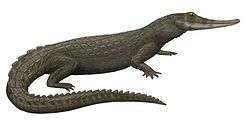Chenanisuchus
| Chenanisuchus Temporal range: Late Cretaceous (Maastrichtian) - Paleocene | |
|---|---|
 | |
| Life restoration of Chenanisuchus lateroculi | |
| Scientific classification | |
| Kingdom: | Animalia |
| Phylum: | Chordata |
| Class: | Reptilia |
| Superorder: | Crocodylomorpha |
| Family: | †Dyrosauridae |
| Genus: | †Chenanisuchus Jouve et al., 2005 |
| Type species | |
| †Chenanisuchus lateroculi Jouve et al. 2005 | |
Chenanisuchus ("Chenane crocodile") is a genus of dyrosaurid crocodyliform from the Late Cretaceous of Mali and the Late Palaeocene of Sidi Chenane in Morocco. It was described in 2005, after expeditions uncovered it in 2000.
The type species is C. lateroculi ("lateralis", lateral; "oculi", eyes), in reference to the laterally facing eyes.
Currently, Chenanisuchus is the most basal known dyrosaurid.[1]
Material
Two specimens of C. lateroculi – OCP DEK-GE 262 (holotype, nearly complete skull with mandibular fragments) and OCP DEK-GE 61 (nearly complete skull) – come from the Sidi Chenane area in Morocco, which is Late Palaeocene (Thanetian) in age.[2] Fossils of Chenanisuchus were also found in Maastrichtian age strata in Mali, what shows that Chenanisuchus survived the Cretaceous–Paleogene extinction event.[3]
Systematics
Chenanisuchus lateroculi is referred to Dyrosauridae by Jouve et al. (2005), based on three morphological characters:
- Presence of occipital tuberosities
- Presence of an anterolateral postorbital process
- Large participation of the quadratojugal and surangular to the jaw joint
Palaeobiology
Chenanisuchus lateroculi has an estimated adult length between 4 and 4.5 meters, based on the 60 centimeter long skull. It has the shortest snout relative to the dorsal skull length among all dyrosaurids.
References
- ↑ Hastings, A.K., Bloch, J. and Jaramillo, C.A. (2011). "A new longirostrine dyrosaurid (Crocodylomorpha, Mesoeucrocodylia) from the Paleocene of north-eastern Colombia: biogeographic and behavioural implications for new-world dyrosauridae" (PDF). Paleontology. 54 (5): 1095–116. doi:10.1111/j.1475-4983.2011.01092.x. Retrieved 14 Sep 2011.
- ↑ Jouve et al., 2005.
- ↑ Hill, Robert V.; McCartney, Jacob A.; Roberts, Eric; Bouaré, Mohamed; Sissoko, Famory; O'Leary, Maureen A. (2008). "Dyrosaurid (Crocodyliformes: Mesoeucrocodylia) Fossils from the Upper Cretaceous and Paleogene of Mali: Implications for Phylogeny and Survivorship across the K/T Boundary". American Museum Novitates. 3631: 1–19. doi:10.1206/598.1.
- Jouve, S., Bouya, B. & Amaghzaz, M., (2005). A short-snouted dyrosaurid (Crocodyliformes, Mesoeucrocodylia) from the Palaeocene of Marocco. Palaeontology 48 (2): 359-369. doi:10.1111/j.1475-4983.2005.00442.x

